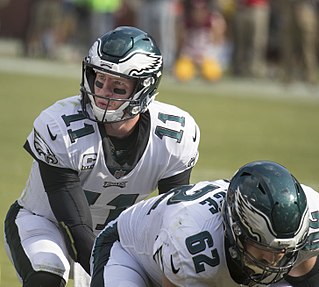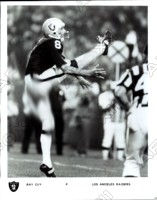
Canadian football, or simply football, is a sport in Canada in which two teams of 12 players each compete on a field 110 yards (101 m) long and 65 yards (59 m) wide, attempting to advance a pointed oval-shaped ball into the opposing team's end zone.

The quarterback (QB) is a position in gridiron football who are members of the offensive side of the ball and mostly line up directly behind the offensive line. In modern American football, the quarterback is usually considered the leader of the offense, and is often responsible for calling the play in the huddle. The quarterback also touches the ball on almost every offensive play, and is almost always the offensive player that throws forward passes. When the QB is tackled behind the line of scrimmage, it is called a sack. The position is also colloquially known as the "signal caller" and "field general".

A wide receiver (WR), also referred to as a wideout, and historically known as a split end (SE) or flanker (FL), is an eligible receiver in gridiron football. A key skill position of the offense, WR gets its name from the player being split out "wide", farthest away from the rest of the offensive formation.
This is a glossary of terms used in Canadian football. The Glossary of American football article also covers many terms that are also used in the Canadian version of the game.
- Legally positioned at the kick-off or the snap. On kick-offs, members of the kicking team must be behind the kick-off line; members of the receiving team must be at least 10 yards from the kick-off line. On scrimmages, at the snap the offence must be behind the line of scrimmage; the defence must be at least one yard beyond the line of scrimmage.
- A player of the kicking team who can legally recover the kick. The kicker and any teammates behind the ball at the time of the kick are onside. Thus on kick-offs all players of the kicking team are onside, but on other kicks usually only the kicker is. The holder on a place kick is not considered onside.
- A defensive position on scrimmages, also called free safety. Typical formations include a single safety, whose main duty is to cover wide receivers. See also defensive back.
- A two-point score. The defence scores a safety when the offence carries or passes the ball into its own goal area and then fails to run, pass, or kick the ball back into the field of play; when this term is used in this sense, it is also referred to as a safety touch.
Strategy plays a crucial role in American football. Both teams carefully plan various aspects of their gameplay in an effort to win. This includes deciding on formations, selecting players for specific positions, and assigning roles and instructions to each player on offense and defense.
American football positions have slowly evolved over the history of the sport. From its origins in early rugby football to the modern game, the names and roles of various positions have changed greatly, some positions no longer exist, and others have been created to fill new roles.
A formation in American football refers to the position players line up in before the start of a down. There are both offensive and defensive formations and many in both categories. Sometimes, formations are referred to as packages.

Center or centre (C) is a position in American football. The center is the innermost lineman of the offensive line on a football team's offense who passes the ball between his legs to the quarterback at the start of each play.

In gridiron football, the holder is the player who receives the snap from the long snapper during field goal or extra point attempts made by the placekicker. The holder is set on one knee seven yards behind the line-of-scrimmage. Before the play begins, the holder places the hand which is closest to the placekicker on the ground in a location designated by the kicker's foot, with their forward hand ready to receive the snap. After receiving the snap, the holder will place the football on the turf, or block, ideally with the laces facing the uprights and the ball accurately placed where the backhand was initially, then balancing the ball with one or two fingers until the ball is kicked.

In American football, a gunner, also known as a shooter, flyer, headhunter, or kamikaze, is a player on kickoffs and punts who specializes in running down the sideline very quickly in an attempt to tackle the kick or punt returner. Gunners must have several techniques in order to break away or "shed" blockers, and have good agility in order to change their running direction quickly. Gunners on the punt team also must be able to block or catch.
A trick play, also known as a gadget play, gimmick play or trickeration, is a play in gridiron football that uses deception and unorthodox tactics to fool the opposing team. A trick play is often risky, offering the potential for a large gain or a touchdown if it is successful, but with the chance of a significant loss of yards or a turnover if not. Trick plays are rarely used not only because of the riskiness, but also to maintain the element of surprise for when they are used.

A halfback (HB) is an offensive position in American football, whose duties involve lining up in the offensive backfield and carrying the ball on most rushing plays, i.e. a running back. When the principal ball carrier lines up deep in the backfield, and especially when that player is placed behind another player (usually a blocking back), as in the I formation, that player is instead referred to as a tailback (TB).

In American football, the specific role that a player takes on the field is referred to as their "position". Under the modern rules of American football, both teams are allowed 11 players on the field at one time and have "unlimited free substitutions", meaning that they may change any number of players during any "dead ball" situation. This has resulted in the development of three task-specific "platoons" of players within any single team: the offense, the defense, and "special teams". Within these three separate "platoons", various positions exist depending on the jobs that the players are doing.
In American football, a play is a close-to-the-ground plan of action or strategy used to move the ball down the field. A play begins at either the snap from the center or at kickoff. Most commonly, plays occur at the snap during a down. These plays range from basic to very intricate. Football players keep a record of these plays in a playbook.
The following terms are used in American football, both conventional and indoor. Some of these terms are also in use in Canadian football; for a list of terms unique to that code, see Glossary of Canadian football.

Buck-lateral is an American football play or a series of plays used in the Single-wing formation. Since the Single-Wing formation lost prominence by 1950, the football play referred to as the buck-lateral is almost gone from football's vocabulary. However, prior to this time, the buck-lateral play gave fullbacks the option to run, lateral, or hand off the ball to another player. Running the buck-lateral required an offensive scheme that needed the fullback to possess many specialized skills, as opposed to today's fullback who mainly blocks and carries the ball infrequently.
In American football, a back is a player who plays off of the line of scrimmage. Historically, the term "back" was used to describe multiple positions on offense and defense, although more descriptive and specific position naming is now common. Thus, "back" can refer to positions including:

In gridiron football, a punt is a kick performed by dropping the ball from the hands and then kicking the ball before it hits the ground. The most common use of this tactic is to punt the ball downfield to the opposing team, usually on the final down, with the hope of maximizing the distance the opposing team must advance in order to score. The result of a typical punt, barring any penalties or extraordinary circumstances, is a first down for the receiving team. A punt is not to be confused with a drop kick, a kick after the ball hits the ground, now rare in both American and Canadian football.

The Colts Catastrophe was an unsuccessful National Football League (NFL) trick play attempted by the Indianapolis Colts against the New England Patriots on October 18, 2015. It occurred near the end of the third quarter in the teams' Week 6 game of the 2015 NFL season.











